Seven Days in Cuba
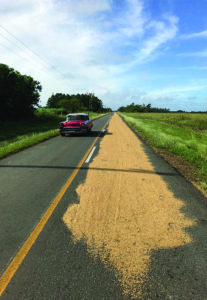 Rice in husks is dried by the side of a road in Cuba. (Photo by Daniel T. Moran)
Rice in husks is dried by the side of a road in Cuba. (Photo by Daniel T. Moran) THE ISLAND OF CUBA and its circumstances, both presently and historically, are not easy subjects. The effect Cuba has had on the United States and its politics goes back more than two centuries, but perhaps more importantly is the profound and enduring effect the US has had on the life of Cuba and its people.
My wife Karen and I had the very recent privilege of spending seven days in Cuba under the auspices of an organization called People to People International. It is presently not easy and now nearly impossible for Americans to set foot on Cuban soil, based upon the dictates of the Cuban government and new directives and policies of the Trump administration. In fact, the rules became more restrictive the very day we departed, and even these special People to People programs are in jeopardy, which prompts me to want to share what I learned in my time there. It is not my intention to make a political argument here, but rather to write from the perspective of a humanist, a poet, and this magazine’s arts editor in the hope that I might be able to scratch away at a pane of glass that has been painted over to see if a little light might be allowed to pass through.
The idea of these People to People programs is to forge communication between Americans and Cubans in a manner that is intimate and personal and provides a poignant exploration of the culture and humanity of the Cuban people. As such, it’s not a vacation in the traditional sense, but more an educational and diplomatic endeavor. For seven days we went from one part of Cuba to another and met with painters, potters, dancers, singers, sculptors, musicians, historians, architects, naturalists, farmers, ranchers, baseball heroes, and even what is, in a way, a new breed of Cuban called an entrepreneur. There are many of those and the number is growing. It was a delightful, colorful, enlightening and exhausting experience that I am unlikely to ever forget.
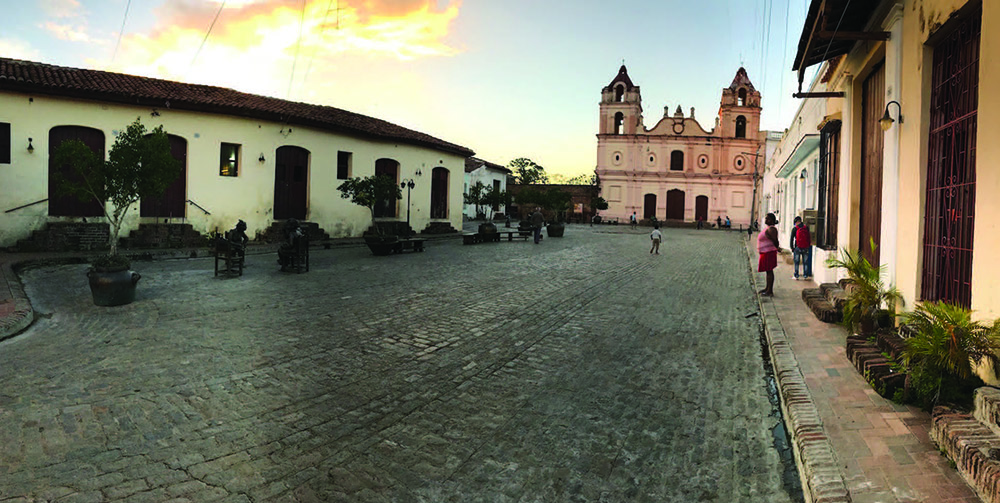
The studio of the famous Cuban painter and sculptor Martha Jimenez situated in the main square of Camagüey. (Photo by Daniel T. Moran)
Historically, Cuba was a colony of Spain that was populated with slaves the Spaniards brought from Africa to cultivate and harvest sugar cane, a new and very desirable commodity in Europe and its colonies in North America. Over centuries the British and the French grappled over the island as well, and the mixture of the indigenous peoples with these groups lent a rich and complex culture to the island that persists today. Cuba only won independence from Spain in 1898, which makes it a relatively new nation. The man credited with achieving that was a poet named José Martí, whose likeness and legend are everywhere in Cuba.
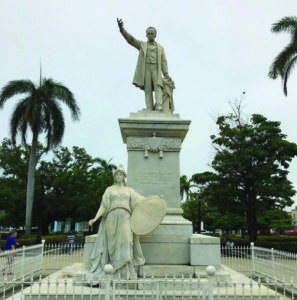
A statue of independence hero José Martí in the main square of Cienfuegos on the southern coast of Cuba. (Photo by Daniel T. Moran)
The present state of things came about with a revolution in 1959 led by Fidel Castro and Ernesto Che Guevara. Our guide described Cuba as “socialist,” which I found to be part truth and part propaganda, but that’s another debate. With the death of Fidel Castro and the ascent of his brother Raúl, there have already been many changes to Cuban society that are very encouraging to the Cubans. The Cuban people, by all accounts, loved and admired Fidel and they mourned his death. They saw him as a savior of sorts who instituted many programs that bettered their lot appreciably in comparison to what they suffered under the profoundly corrupt regime of Fulgencio Batista. The problem is that Fidel accomplished it by repression and subjugation, sometimes brutal in nature. Incidentally, he holds the Guinness world record for most attempts on his life, at 638. Clearly he wasn’t loved by all of his people. Like with religion, living under a certain set of beliefs and circumstances for long enough can seriously warp one’s sense of reality. Surely the Cuban people have such delusions. It’s not unlike what was said about Benito Mussolini, that no matter what people accused him of, he made the trains in Italy run on time. There are things of which the Cuban people are very proud, among them the fact that they get free education and healthcare. For people who have very little materially, these are not small things.
We had a Cuban guide whose particular circumstances speak to the way things are for many Cubans at the moment. A young woman who came from a family of very modest means, as a young girl she aspired (as many do) to a career in the tourism industry. She went to university for free and earned a master’s degree that taught her all the things she would need to know to guide foreigners around Cuba. Her knowledge on all things Cuban was more than impressive.
Our group of twenty-eight Americans asked her many questions, one of which was how much she got paid. Everyone in Cuba is on the payroll of the Cuban government, which effectively owns everything. The things it doesn’t own are sanctioned and supplied by it. Our guide told us that her monthly salary was the equivalent of fifty US dollars (even physicians earn similar paltry sums). It wasn’t enough for her to have her own home or apartment. Many young Cubans continue to live with their parents even after they marry. Of course, this helps family unity and domestic sustainability. It’s also a trap from which there is little chance of escape, and young people aren’t able to have the independence that would allow their imaginations and worldview to expand and flourish.
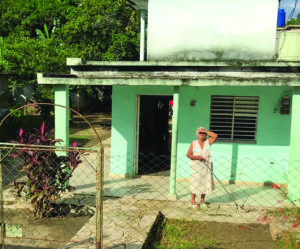
A woman outside her house in Camagüey, Cuba’s third largest city and municipality. (Photo by Daniel T. Moran)
In the case of our guide, she knows that Americans are generous people and it’s not unlikely that, after a week of hard work, she might well get as much in tips from her new tourist friends as she would earn from the Cuban government in a year. My wife and I gave her fifty dollars, an amount that might buy us a nice lunch in New Hampshire but is what she earns in salary in a month. Although it’s illegal for Americans to send anything to Cubans they aren’t related to (under an embargo imposed by the late John F. Kennedy), it is legal for family members in the US to send things, including money, and so there’s an avenue than can be exploited. Many Cubans have found similar ways around the system and the government doesn’t seem to discourage it. Cubans are now allowed to own businesses, like restaurants (called paladars), from which the government assesses taxes. Many of these businesses are financed by family members in the United States. (In all the places we ate, we got to meet the owner. To one of them I said, “Viva la entrepreneur!”) Like all Cubans, our guide cannot just take her money and leave. Cubans traveling to the US must obtain special permission, and the application, at about $150, is prohibitive for almost all of them, especially since the chances of the application being approved are very small, and the fee is nonrefundable.
But here is what I really want people to know: our experiences with the people of Cuba were extraordinary, and Cuba has one of the richest cultures we have ever experienced in all of our travels. The people are passionate, resourceful, creative, and, I dare say, happy. Unlike many Americans, they don’t seem to concentrate on what they don’t have, but on what they do have.
As I mentioned, things loosened up a bit for the better after Raúl Castro took control in 2008 and after the death of Fidel Castro last year. The so-called Cuban thaw began in 2014 when President Barack Obama and Raúl announced the beginning of a normalization of relations, which included the lifting of certain travel and financial restrictions, along with the reopening of the US embassy in Havana and the Cuban embassy in Washington, DC. Obama’s trip to Cuba in early 2016 also had an enormous impact on the people there, he being the first sitting American president to set foot on Cuban soil since Calvin Coolidge in 1928. They fell madly in love with Obama and shared stories of where he had visited, and if they’d had the chance to see his car pass. They had suffered greatly since the embargo imposed by Kennedy in 1960 and they were brimming with hope that there would be a new life for them when Obama eased the restrictions on tourism and imports. They quickly readied themselves to accept what they imagined would be a tidal wave of Americans flowing into Cuba, many of whom would report (like my wife and myself) that they wanted to see Cuba before it changed. Ironically, it now seems President Trump is intent on preserving the Cuba of little freedom or opportunity.
I made a point of telling as many people as I could that the majority of Americans don’t support the policies of Donald Trump, especially with regard to Cuba. They were reluctant to speak on the matter, but asked simply why he was reversing course. I had no good answer. What is clear is that for nearly sixty years the US government punished the people of Cuba because they were being ruled by a dictator unfriendly to the United States, in the misguided hope that those very people would capitulate to our pressure and rise up to overthrow Fidel Castro. It’s a strategy that has never worked anywhere in the world.
In the first year of the Trump era, relations between the two nations have returned to a level only slightly less disagreeable than it was the day after the failed Bay of Pigs invasion in 1961. Trump, with no evidence whatsoever, has accused the Cuban regime of firing some kind of sonic ray gun at our embassy in Havana, causing considerable harm to our diplomatic staff working at the facility. What’s clear is that something did happen to American (and Canadian) diplomats, and while the cause has not yet been identified, Trump says with conviction and not even the flimsiest proof that the Cuban government is to blame. Still, it has worked yet again and many Americans have cancelled trips to visit Cuba following a State Department advisory that such travel is unsafe. To get to Cuba I had to pass through Manchester, New Hampshire; Newark, New Jersey; and Miami, Florida—all places that are demonstrably less safe than Havana. In a broad sense, what could possibly be gained by the Cuban government concocting a scheme to drive tourists, and especially American tourists, out of Cuba?
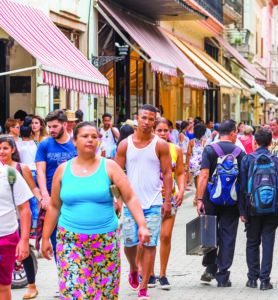
People on a Havana street, May 5, 2017. (Photo by Gerold Grotelueschen | Dreamstime)
In my conversations with Cubans I tried to explain something about the American political process and just how important the state of Florida is in deciding our presidential elections. I also pointed out that a very important and highly motivated faction of that electorate—Cuban-American voters, whose longstanding opposition to the Cuban regime is well known—is part of the reason why Trump has played the card he’s played. I also explained another pathetic reality about the Trump agenda: he seemingly is determined to do little else but to reverse and undermine and cancel every decision made by Obama during his eight years in office. In that regard, and only in that regard, Trump is an almost unqualified success.
My final reassuring word to the Cubans I met was to be patient. The American system of government was designed to correct these kinds of circumstances and, before long, the path chosen by Obama to create a peace between our countries, opening the doors of Cuba to American commerce and American ideas and ideals, will be reestablished. The people of Cuba count their patience by generations—I feel sure that patience will be rewarded.
